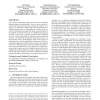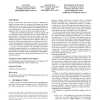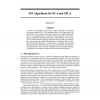1380 search results - page 264 / 276 » Learning Hierarchical Shape Models from Examples |
WSDM
2012
ACM
12 years 3 months ago
2012
ACM
It is well known that different types of social ties have essentially different influence between people. However, users in online social networks rarely categorize their contact...
QRE
2010
2010
Improving quality of prediction in highly dynamic environments using approximate dynamic programming
13 years 6 months ago
In many applications, decision making under uncertainty often involves two steps- prediction of a certain quality parameter or indicator of the system under study and the subseque...
KDD
2009
ACM
14 years 8 months ago
2009
ACM
In large social networks, nodes (users, entities) are influenced by others for various reasons. For example, the colleagues have strong influence on one's work, while the fri...
NIPS
1997
13 years 9 months ago
1997
I present an expectation-maximization (EM) algorithm for principal component analysis (PCA). The algorithm allows a few eigenvectors and eigenvalues to be extracted from large col...
ATAL
2010
Springer
13 years 8 months ago
2010
Springer
In open, dynamic multi-agent systems, agents may form short-term ad-hoc groups, such as coalitions, in order to meet their goals. Trust and reputation are crucial concepts in thes...



